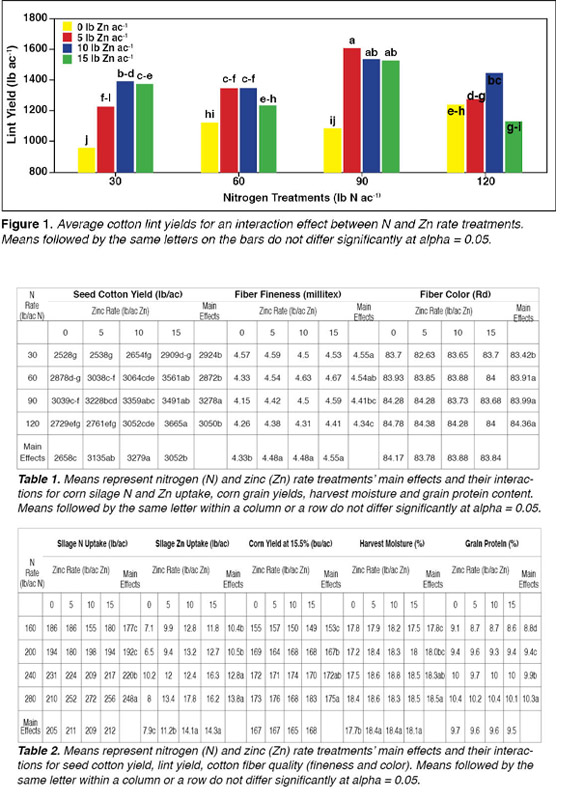Research Project
Zinc and Nitrogen Rates Effects on Corn-Cotton Production in Humid Subtropics of Mississippi
Investigators: Gurbir Singh, Gurpreet Kaur
Date: 2021
Project Summary
Introduction
Zinc deficiency symptoms have continued to surface over the past several years and have been evident in both corn and cotton. The problem has been most evident on the sandier soils where organic matter levels are generally less than 1%. Efforts have been underway in the Mississippi Delta to increase organic matter levels by utilizing crop rotations. Soil test zinc has been observed in the deficient range and could be increased with zinc fertilizer applications. Both soil-applied and foliar products are available, but application can be quite expensive. Research at the Delta Research and Extension Center has shown significant yield increases when cotton follows corn compared to cotton following cotton. The advantage has averaged from 10-17% on a series of studies to over 20% in the Centennial Rotation. The objectives of this study were to evaluate the interaction of nitrogen rates and zinc rates for optimizing corn and cotton yields in rotation on irrigated sandy soils and to determine the economic impact of the nitrogen and zinc applications while optimizing all other inputs.
Materials and Methods
A corn-cotton rotation system is currently in place was used to evaluate the interaction of zinc rates and nitrogen rates for both the corn and cotton crops. The studies are located at the Delta Research and Extension Center with four N rates (Corn: 160, 200, 240, and 280 lb/ ac N; Cotton: 30, 60, 90, and 120 lb/ac N) and four zinc rates (0, 5, 10, and 15 lb/ac Zn). The experiment is set up in a randomized complete block design with five replications. Zinc sulfate has been used by dissolving in water and applied as a sidedressed band with a coulter rig, similar to urea-ammonium nitrate solution, to each side of the planted row. Seedbed preparation was accomplished in fall 2020. In spring 2021, seedbeds were rolled down and planted with corn hybrid DKC 70-27 at 32,000 seeds/ac on 4/5/2021. Cotton hybrid DP 1646 B2XF was planted on 5/17/2021 at 46,000 seeds/ac. Pre-emergence nitrogen was applied at 120 lb/ac N to corn and 30 or 60 lb/ ac N to cotton on 4/6/2021 and 5/20/2021, respectively. The remaining N was applied as a split application to all the treatments to corn on 5/24/2021 and cotton on 6/21/2021. During preplant sidedressed application of N, zinc sulfate was also applied to the treatments. Corn biomass samples were collected from all treatments to determine silage yield. Corn biomass samples were oven-dried, weighed, grounded, and analyzed for nitrogen and zinc concentration to determine N and Zn uptake by corn. Corn was harvested on 9/3/2021 using a Kincaid 8XP plot combine and grain samples were collected to determine grain harvest moisture, bushel test weight, seed index (100-seed weight), and grain quality (protein, starch, and oil). Cotton boll samples were collected prior to picking cotton and will be processed for lint yield and fiber quality. Cotton was picked using a two-row cotton picker on 10/11/2021. After harvesting, soil samples were collected for determining available nutrients in soils. All data were statistically analyzed using the glimmix procedure in SAS statistical software. Nitrogen and zinc rates were treated as fixed factors and replications of the treatment were random factor. The model parameters were tested at alpha = 0.05. Mean comparisons were made using the T-grouping method with LSMEANS statement.
Results and Discussion
There were no interaction effects of Zn and N rate application for corn silage N uptake, corn silage Zn uptake, corn grain yield, corn grain protein content and harvest moisture in 2021. However, corn silage N uptake, corn grain protein content and corn yield were affected by the main effects of N rate application (Table 1). The highest yield of 175 bu/ac was received with 280 lb/ac N. Corn yield for 240 and 280 lb/ ac N was similar between both treatments and was at least 19 bu/ac greater when compared to 160 lb/ac N treatment. Corn silage Zn uptake was more than 14.1 lb/ac for the 10 and 15 lb/ ac Zn treatments when averaged over N application treatments. Harvest moisture for corn increased as the N application rate was increased when averaged over the Zn application treatments. Seed cotton yield was affected by the twoway interaction of N and Zn rate treatments (Table 2). The lowest seed cotton yield of 2528 lb/ac was observed in the 30 lb/ac N + 0 lb/ac Zn treatment whereas a higher seed cotton yield of 3278 lb/ac was observed in the 120 lb/ac N + 15 lb/ac Zn treatment. When N was applied at 30, 90, and 120 lb/ac with 10 or 15 lb/ac Zn, the seed cotton yield showed no significant differences (Table 2). Cotton lint yield also showed an interaction effect and highest cotton lint yield of 1611 lb/ac was achieved with the 90 lb/ac N + 5 lb/ac Zn treatment (Figure 1). This yield was not different when additional Zn was added with 90 lb/ac N treatment. Therefore, agronomic optimum cotton yield can be achieved with a fertilizer rate of 90 lb/ac N plus 5 lb/ac Zn. Cotton fiber fineness showed difference only with the main effects where cotton fiber fineness decreased with increasing rate of N application. In contrast, cotton fiber fineness increased with increasing rate of Zn application. Cotton fiber color showed significant differences with only N application rates (Table 2).
Project Photos

- Crop Type:
- Corn
- Topic:
- Soil
Find Research
By Crop Type
By Topic
Contact NCAAR
General Information
Kaye Sullivan
vfs23@msstate.edu
662.390.8510
F:662.390.8501
Showcase Demo
Drew Gholson, Coordinator
drew.gholson@msstate.edu
662.390.8505
Himmy Lo
himmy.lo@msstate.edu
662.390.8509

